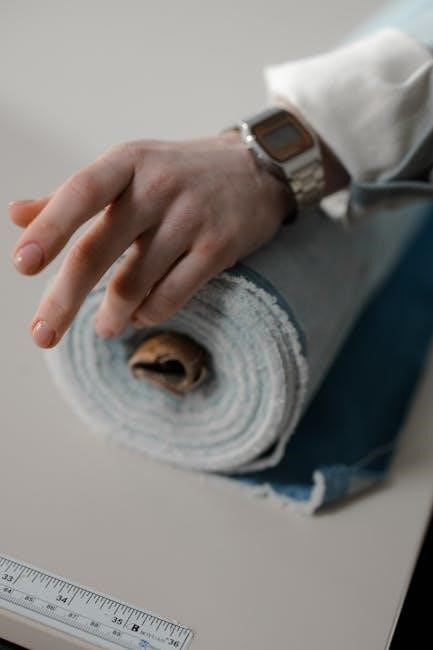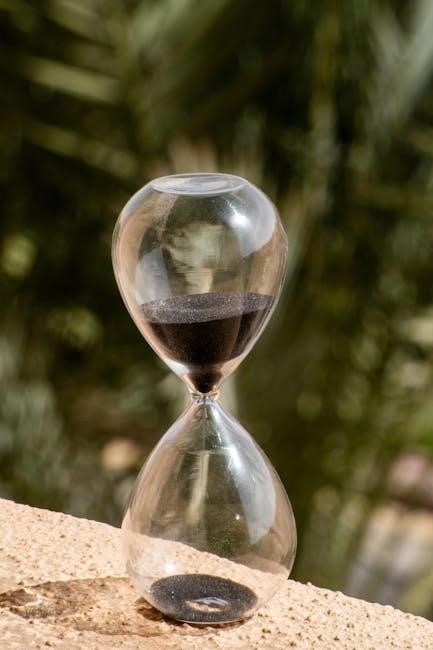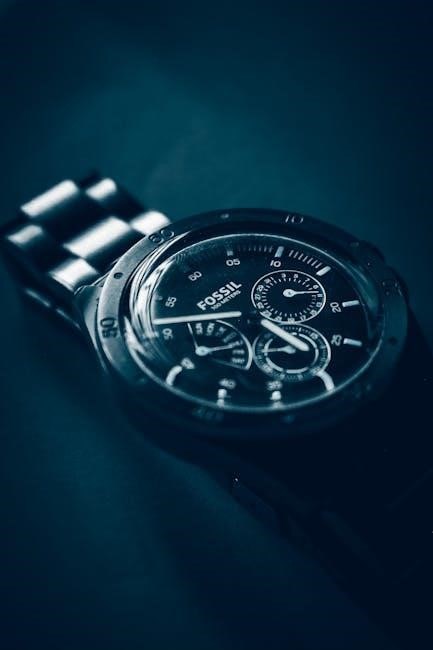Accurate watch measurements are crucial for functionality and style. This guide covers key aspects such as case diameter, band width, and wrist size to ensure the perfect fit and aesthetic appeal.
1.1 Importance of Accurate Measurements
Accurate watch measurements are essential for ensuring a perfect fit and optimal functionality. A well-fitted watch enhances comfort and aesthetic appeal, while improper sizing can lead to discomfort or a mismatched appearance. Measurements like case diameter, lug-to-lug length, and wrist size are critical for selecting a watch that complements your style and proportions. Incorrect sizing can result in a watch that is too tight or too loose, potentially causing irritation or difficulty in reading the time. Additionally, precise measurements help in choosing the correct strap size, ensuring the watch sits securely and comfortably on the wrist. Accurate measurements also play a role in maintaining the watch’s functionality, such as ensuring buttons and crowns are easily accessible. Thus, understanding and applying accurate measurement techniques is vital for both practicality and style.
1.2 Brief Overview of Key Measurements
When measuring a watch, several key dimensions are considered to ensure the best fit and functionality. The case diameter is the most common measurement, referring to the width of the watch face. Another critical measurement is the lug-to-lug length, which measures the distance between the lugs, where the strap attaches to the case. This affects how the watch sits on the wrist. The case height or thickness is also important, as it determines the watch’s profile and comfort under cuffs. Additionally, the wrist size is measured to match the watch’s dimensions, ensuring it is neither too tight nor too loose. Accurate measurements of the lug width and strap length are essential for selecting the right band. Understanding these key measurements helps in choosing a watch that is both comfortable and visually appealing, making it a perfect accessory for any occasion.

Watch Case Measurements
Watch case measurements include case diameter, lug-to-lug length, and case height. These dimensions determine comfort, style, and how the watch sits on the wrist, ensuring a perfect balance of functionality and aesthetics.

2.1 Case Diameter Measurement

The case diameter is the most common measurement when discussing watches, representing the width of the watch case from one side to the other. It is typically measured in millimeters and does not include the crown or lugs. To measure accurately, use calipers or a ruler across the case’s widest points. Standard diameters range from 28mm to 46mm for men and 23mm to 34mm for women, though modern trends favor larger sizes. The diameter significantly impacts the watch’s appearance on the wrist, with smaller sizes suiting delicate wrists and larger sizes complementing broader wrists. While diameter is crucial, it is essential to consider other measurements like lug-to-lug length and case thickness for a comprehensive fit assessment. Always ensure your measurement tool is precise to select a watch that balances style and comfort effectively.
2.2 Lug-to-Lug Length Measurement
The lug-to-lug length measures the distance from the top of the upper lug to the bottom of the lower lug on a watch case. This measurement is crucial as it determines how the watch will sit on the wrist. A longer lug-to-lug length can make the watch appear larger and may extend beyond smaller wrists, while a shorter length is more proportionate for petite wrists. To measure accurately, use calipers or a ruler, ensuring the measurement is taken from the top of the upper lug to the bottom of the lower lug. For example, a watch with a 42mm case diameter might have a lug-to-lug length of approximately 47mm. This measurement, often overlooked, significantly impacts the wearer’s comfort and aesthetic balance, making it essential for selecting the right watch size.
2.3 Case Height Measurement
Case height, also known as the thickness of the watch, is the measurement from the top of the bezel to the bottom of the caseback. This dimension affects how the watch sits on the wrist and its overall profile. A thinner case height is ideal for formal occasions, while a thicker case suits sports or diving watches. To measure accurately, use a ruler or calipers, placing one end at the top of the bezel and the other at the caseback. For example, a typical dress watch might have a case height of 10mm, while a diving watch could be 15mm. This measurement, combined with the case diameter and lug-to-lug length, helps determine the watch’s wearability and style suitability. Ensuring the case height complements wrist size and personal preference is key to a comfortable and elegant fit;
2.4 Understanding Case Thickness
Case thickness refers to the vertical measurement of the watch case, from the top of the bezel to the back of the case. This dimension plays a significant role in the watch’s overall design and comfort. Thinner cases (around 8-12mm) are often preferred for dress watches, as they fit easily under cuffs and provide a sleek appearance. Thicker cases (12-16mm or more) are commonly seen in sports or diving watches, where durability and functionality are prioritized. To measure case thickness accurately, use calipers or a precise ruler. Place one end on the bezel and the other on the caseback, ensuring the measurement is taken perpendicular to the surface. Proper understanding of case thickness helps in selecting a watch that balances aesthetics with functionality, ensuring it suits both personal style and intended use. This measurement, combined with case diameter and lug-to-lug length, ensures a harmonious fit and design.
Watch Band and Strap Measurements
Watch bands and straps are measured by their lug width and length. Lug width is the distance between the case lugs, while band length ensures a proper fit around the wrist, balancing comfort and style.

3.1 Lug Width (Band Width) Measurement
Lug width, also known as band width, is the distance between the inner edges of the watch lugs where the strap or bracelet attaches to the case. This measurement is critical for ensuring the band fits securely and aligns properly with the watch case. To measure lug width accurately, use calipers or a millimeter ruler. Place the tool between the inside of the lugs and record the measurement in millimeters. Common lug widths include 18mm, 20mm, and 22mm, with 20mm being the most common for men’s watches. If unsure, refer to the watch manufacturer’s specifications or measure an existing band. Precise measurement prevents issues like ill-fitting bands or spring bar misalignment. Always round to the nearest whole number, as bands are typically available in standard sizes. This ensures a seamless fit and optimal comfort for the wearer.
3.2 Band Length Measurement
Band length is measured from one end of the strap to the other, excluding the buckle, to ensure proper fit around the wrist. To measure accurately, lay the band flat and record the distance in millimeters. For leather or nylon straps, measure from the tip to where the buckle attaches. For metal bracelets, count the links or measure the total length. Common lengths range from 115mm to 145mm for men and 105mm to 125mm for women, depending on wrist size. If unsure, use a flexible measuring tape around your wrist to determine the ideal length. Always check the manufacturer’s sizing chart, as some bands may have specific measurements. Accurate band length ensures comfort and proper fastening, avoiding a band that is too tight or too loose. This step is essential for both new purchases and replacement straps to guarantee a perfect fit.
3.3 How to Choose the Right Band Size
Choosing the right band size involves measuring both your wrist and the watch case. Start by wrapping a flexible measuring tape or a piece of string around your wrist at the point where the watch will sit. Mark the point where the ends meet and measure the length with a ruler. For a snug fit, add 1-2 cm to this measurement. Next, ensure the band width matches the lug width of your watch, as mismatched sizes can cause the strap to fit poorly. Common lug widths range from 18mm to 22mm. For example, a 20mm lug width requires a 20mm band. Consider the watch’s thickness and your personal style to balance comfort and aesthetics. By combining these measurements, you can select a band that fits perfectly and complements your watch.

Wrist Size Measurement
Measure your wrist using a tape or string where the watch will sit. Mark the meeting point, lay it flat, and measure with a ruler for an accurate fit and comfortable wear.
4.1 How to Measure Your Wrist
To accurately measure your wrist, wrap a flexible tape measure or a piece of string around the center of your wrist, where the watch will sit. Ensure the tape is snug but not too tight. If using a string, mark the point where the ends meet, then lay the string flat on a ruler to measure the length in millimeters or inches. This measurement will help determine the ideal watch size and band length for a comfortable fit. For best results, measure at the narrowest part of your wrist, just above the wrist bone. This method ensures a precise fit, whether you’re choosing a leather strap, metal bracelet, or rubber band. Accurate wrist measurement is essential for selecting a watch that complements your style and provides all-day comfort.
4.2 Relating Wrist Size to Watch Size
Understanding the relationship between wrist size and watch dimensions is key to selecting a timepiece that feels comfortable and looks proportional. A watch that is too large or small for your wrist can be uncomfortable and visually unappealing. Generally, smaller wrists (6-7 inches) pair well with watches featuring case diameters of 36-40mm, while larger wrists (7.5-8 inches) can accommodate watches with case diameters of 42-44mm. The lug-to-lug length also plays a role, as it determines how the watch sits on the wrist. For instance, a watch with a shorter lug-to-lug length is ideal for smaller wrists, while a longer length suits larger wrists. By measuring your wrist and comparing it to the watch’s dimensions, you can ensure a balanced fit that enhances both comfort and style. This relationship is crucial for finding a watch that complements your anatomy and personal taste.

Tools Needed for Measurement
Essential tools include calipers for precise lug width and case diameter measurements, a ruler for basic length and width assessments, and a measuring tape to determine wrist size accurately.

5.1 Calipers for Precise Measurements
Calipers are indispensable for obtaining precise watch measurements. They provide accurate readings of lug width, case diameter, and case height, ensuring a perfect fit for watch bands and straps. By inserting the calipers between the lugs and expanding them to measure the interior distance, you can determine the exact lug width in millimeters. This tool is particularly useful for measuring the interior distance between the lugs, which is critical for selecting the correct strap size. Additionally, calipers can measure the case thickness and diameter with high precision, making them a must-have for both watch enthusiasts and professionals. Regular use of calipers ensures that all measurements are consistent and reliable, avoiding any guesswork when fitting or replacing watch bands.
5.2 Using a Ruler for Basic Measurements
A ruler is a practical tool for basic watch measurements, offering simplicity and accessibility. It is ideal for measuring the length and width of watch bands or straps. To measure the length, lay the band flat and measure from one end to the other, excluding the buckle. For the width, measure the band where it connects to the lugs and at the clasp end. While rulers are less precise than calipers, they provide a good starting point for basic sizing needs.
When using a ruler, ensure the measurements are taken in millimeters for accuracy. If measuring in inches, convert the result to millimeters using a conversion chart. This method is particularly useful for determining the lug width and ensuring the band fits correctly. Always double-check your measurements to avoid sizing errors. This straightforward approach makes rulers a handy tool for anyone looking to measure their watch or band quickly and effectively.
5.3 Measuring Tape for Wrist Size
A measuring tape is essential for accurately determining wrist size, a critical factor in selecting the right watch. To measure, wrap the tape around your wrist at the point where the watch will be worn, ensuring it is snug but not overly tight. Mark where the two ends of the tape meet, then lay it flat on a ruler to record the measurement. This method provides a precise wrist size in millimeters or inches, which can then be compared to watch sizes. For example, a 7-inch wrist typically fits a 40-42mm watch case. Always double-check the measurement to ensure accuracy, as this directly impacts the comfort and appearance of the watch. Using a measuring tape is a simple yet effective way to ensure the perfect fit for your timepiece.

Additional Considerations
Consider watch thickness for comfort, lug width relative to case diameter for aesthetics, and standard size guidelines to ensure the best fit and functionality for your timepiece.
6.1 Impact of Watch Thickness
Watch thickness, or the height of the case, significantly impacts comfort and aesthetics. A thinner profile often suits formal settings, while thicker watches may appeal to sports enthusiasts. Ensure the thickness complements your wrist size and personal style for optimal wearability.
6.2 Lug Width vs. Case Diameter
Lug width and case diameter are distinct measurements that influence a watch’s fit and appearance. While case diameter refers to the watch’s width, lug width determines the strap size. Both must align with wrist size for comfort and style.
6.3 Common Watch Size Standards

Understanding common watch size standards helps in selecting the right timepiece. For men, case diameters typically range from 36mm to 46mm, while women’s watches usually fall between 26mm and 34mm. Lug widths are standardized, with 18mm, 20mm, and 22mm being the most common. These measurements ensure compatibility with straps and bracelets. For example, a 20mm lug width is versatile and widely available. Standardized sizes simplify the process of choosing accessories, as they ensure a proper fit. However, individual preferences may vary, so measuring your wrist and understanding your watch’s dimensions is essential. These standards also guide manufacturers, ensuring consistency across designs. By adhering to these norms, watches maintain functionality and aesthetic appeal, making them suitable for various wrist sizes and styles. This consistency is key to the timeless appeal of watches in the industry.
